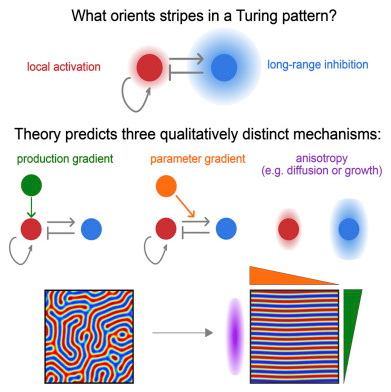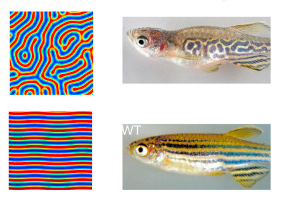|
|||||||||||||||
|

CLICK ON weeks 0 - 40 and follow along every 2 weeks of fetal development
|
|||||||||||||||||||||||||||
|
A mathematical model for animal stripes The back of a tiger could have been a blank canvas. Instead, nature painted the big cat with parallel stripes, evenly spaced and perpendicular to its' spine. Scientists don't know exactly how stripes develop, but mathematicians since the 1950s have been modeling possible scenarios. In Cell Systems on December 23, 2015, Harvard researchers assembled a range of these scenarios into one, single equation to identify what controls stripe formation in all living things. "We wanted a very simple model in hopes it would be big picture enough to include all of the different explanations ... what is common among molecular, cellular, and mechanical hypotheses for how living things orient the directions of stripes ... what kinds of experiments will or won't distinguish between them," explains lead author Tom Hiscock, a PhD student in Sean Megason's systems biology lab at Harvard Medical School. Stripes are surprisingly simple to model mathematically. Much of the early work on the subject was by Alan Turing a British pioneering computer scientist, mathematician, logician, cryptanalyst and theoretical biologist. Recently, Turing was portrayed in the movie The Imitation Game. These patterns emerge when interacting substances create waves of high and low concentrations of a chemical, a pigment, or type of cell. What Turing's model doesn't explain is how stripes orient themselves in one particular direction.
What we don't know is how this translates to living things. What is the variable for a tiger that pushes its' development of perpendicular stripes?
Although this paper is based in theory, Hiscock believes we are close to having experimental tools that can decipher whether the math holds true in living systems. Abstract Highlights The work was supported by the National Institutes of Health and the Herchel Smith Graduate Fellowship. Cell Systems, Hiscock and Megason: "Orientation of Turing-like Patterns by Morphogen Gradients and Tissue Anisotropies," http://dx.doi.org/10.1016/j.cels.2015.12.001 Cell Systems (@CellSystemsCP), published by Cell Press, is a monthly journal featuring papers that provide, support, or apply systems-level understanding in the life sciences and related disciplines. Research describes novel discoveries, milestone achievements, applied research, translational findings, broadly useful tools or resources, or insights into the use of technology. For more information, please visit http://www.cell.com/cell-systems. To receive media alerts for Cell Press journals, contact press@cell.com. |
Jan 8, 2016 Fetal Timeline Maternal Timeline News News Archive 
|
|||||||||||||||||||||||||||


